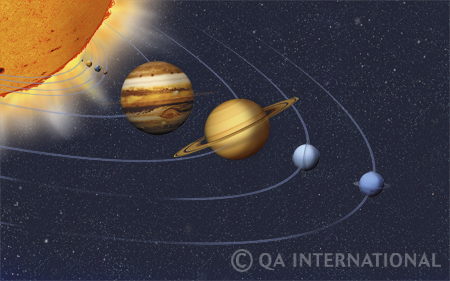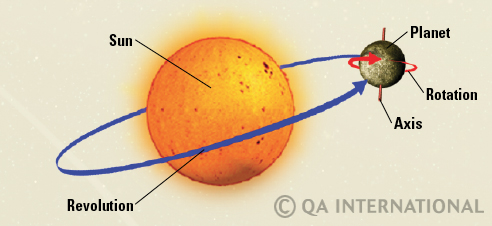
The solar system, our own little corner of the universe
The solar system is our own little corner of the universe. It consists of a central star, which is the Sun, and everything that travels around it: 8 planets, 3 dwarf planets, more than 160 moons, millions of comets, almost a million asteroids, billions of pebbles, cosmic dust, and gases… The Sun is the largest object in the solar system. Its enormous mass gives it a force of attraction powerful enough to keep the planets and the dwarf planets circling around it! The Sun even attracts the distant dwarf planet Eris, located more than 5,5 billion miles (9 billion km) away! The eight planets travel around the Sun on its own ellipse, or oval-shaped course. Most of them are not alone on their journeys. They often travel with one or more natural satellites, which are called moons.
The planets

To be a planet, a celestial body must meet four conditions. It must not be a star, it must revolve around the Sun, it must have sufficient mass to give it an almost spherical shape and its mass must also be large enough to allow it to repel or attract celestial bodies that are in its neighborhood. The planets are classified in two groups, according to their composition: rocky planets and gaseous planets. As their name indicates, rocky planets are mainly made up of rocks. They include Mercury, Venus, Earth and Mars. The rocky planets, also known as terrestrial planets, are closest to the Sun. An asteroid belt separates them from the four planets that follow. Unlike the small rocky planets that all have a solid surface, the gaseous planets, or Jovian planets, are giant balls of gas. They include Jupiter, Saturn, Uranus and Neptune.
The planets in motion
The planets move in space, circling the Sun. This movement is called revolution. One complete revolution of a planet around the Sun corresponds to the planet’s year. Traveling this way around the Sun, each planet spins like a top on its axis, which is a kind of imaginary stick that runs right through the middle of the planet. This movement is called rotation. One complete rotation corresponds to the planet’s day.

Planets among-the stars?
From Earth, five planets can be observed with the naked eye: Mercury, Venus, Mars, Jupiter, and Saturn. At first sight they look like any of the stars surrounding them. Early astronomers noticed, however, that certain bright points of light changed their positions in the sky, from month to month, unlike the other stars that seemed to remain fixed in place. They called these moving stars “planets,” which comes from the Greek word planêtês, meaning “wanderer.”
Also see:
In the Visual Dictionary:
In the encyclopedic capsules:
- The galaxies
- Meteorites: these stones fallen from the sky
- Earth: a rocky planet
- The Moon, our own natural satellite
- Space exploration: probes and shuttles
In the ikonet games:
- Put it in its place!: phases of the Moon
- Put it in its place!: meteorite
- Put it in its place!: star
- Put it in its place!: cross section of an astronomical observatory
- Put it in its place!: orbiter




